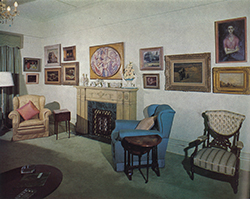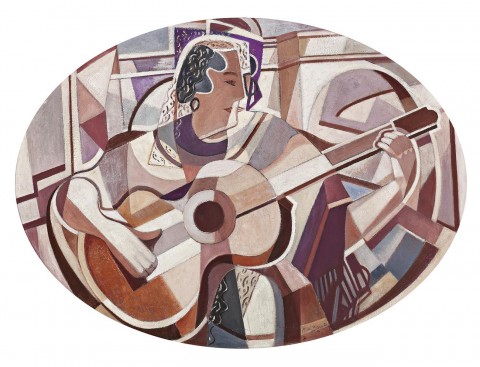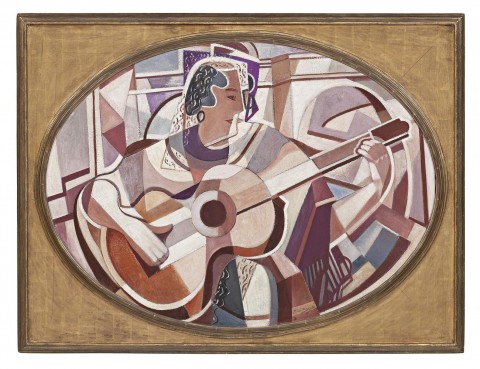FIGURE WITH GUITAR, c.1932 – 35
ROY DE MAISTRE
oil on board
72.5 x 99.0 cm (oval)
signed lower right: R. de Maistre
signed and inscribed with title verso: FIGURE WITH GUITAR … / BY / ROY L DE MAISTRE / 13 ECCLESTON
label attached verso: James Bourlet & Sons, Ltd London
bears inscription on frame verso: 2
Roland and Beatrice Instone, Sydney, c.1940s
Christie’s, Sydney, 1 October 1974, lot 70
Ken and Joan Plomley Collection of Modernist Art, Melbourne
Contemporary Group Exhibition, Farmer’s Blaxland Gallery, Sydney, 21 – 30 June 1939, cat. 53
Thomas, D., ‘the art collectors 8: Roland Instone’, Art and Australia, Ure Smith, Sydney, vol. 6., no. 2, September 1968, pp. 113 (illus.), 114 (illus. in interior)
Ingram, T., ‘Saleroom. De Maistre – not a discordant note among those who mattered’, The Australian Financial Review, Sydney, 26 September 1974, p. 28
190105 - Supplementary Image.jpg

WALL AT INSTONE HOUSE, SYDNEY
Figure with Guitar, c.1932 – 35, is a major early example of Roy de Maistre’s fascination with Cubism. Its large ovato tondo shape is unique in his oeuvre and features as its subject a female guitarist that the artist had first sketched ‘in front of the bridge in Toledo’,1 seen looming behind her. De Maistre had already painted two realist studies of the Alcántara Bridge, an arched stone construction dating from the Roman Empire (see lot 5) but in Figure with Guitar, the location is of little importance. Instead, de Maistre uses the motif as the basis for a complex examination of artistic possibility within design and composition, features which mark the majority of his paintings done in Europe following his relocation to London in 1930.
For de Maistre and many of his peers in Sydney’s artworld, Picasso was recognised as a giant, a seemingly endless font of ideas and strategies. However, little of Australia’s modernist artwork from the 1920s actually bore signs of his influence. Partially this was due to local opposition to the extremes of the European avant-garde as well as the fact that few in the country had ever seen an original by the Spanish master. In this regard, de Maistre’s Train, c.1930 (private collection) is possibly the first painting executed in this country which utilises the Cubist strategy of divided planes and angles to suggest multiple, simultaneous viewpoints. Of the London paintings, The Crucifixion, 1932 – 46 (Art Gallery of New South Wales), bears the earliest date for a painting displaying Cubist roots.
De Maistre’s approach to Cubism has sympathies with the similar variations that the artists André Lhote and Jean Metzinger employed. Juan Gris should also be added to this mix, the painter once described by Robert Hughes in Shock of the New as having brought a ‘broader, more cogent, almost classical air’ to Cubism, allied with ‘a mind of the coolest analytical temper’.2 Such a description could easily be applied to de Maistre, who would refuse to open the door when he was working, such was his focus. In Figure with Guitar, as with all his artwork, there is never a line out of place, each is considered and composed, augmented by shifts in colour, however subtle, which recall the luminosity of his ‘colour-music’ paintings of 1918 – 20. Further, Figure with Guitar was painted during the period when de Maistre and his young protégé Francis Bacon were forensically examining and responding to Picasso’s art. The artist’s affinity to the guitar player should also be considered as De Maistre was a trained violinist. A related and much reproduced drawing, Seated figure (Margaret McLeod), 1935 (Art Gallery of New South Wales), likewise features a lute next to the chair and is also a Cubist response to the subject.3 In 1968, Daniel Thomas wrote an article about the prestigious Roland Instone Collection for Art in Australia. Featured in the photographs was Figure with Guitar hanging over the fireplace in the centre of the room amidst a cluster of other significant paintings, the position it had held since its purchase in the late 1940s. This auction marks only the second time Figure with Guitar has been offered for sale since it left the Instone Collection in 1974, described at the time in the media as being ‘probably the most important de Maistre to come on the auction market in recent years’.4
1. Thomas, D., ‘the art collectors 8: Roland Instone’, Art and Australia, Ure Smith, Sydney, vol. 6, no. 2, September 1968, p.113
2. Hughes, R., The Shock of the New, BBC, London, 1991, p. 34
3. Seated figure (Margaret McLeod) was first reproduced in the second edition (1935) of Herbert Read’s influential book Art Now: An introduction to the theory of modern painting and sculpture, Faber and Faber, London, 1933
4. Ingram, T., ‘Saleroom. De Maistre – not a discordant note among those who mattered’, The Australian Financial Review, Sydney, 26 September 1974, p. 28
ANDREW GAYNOR

